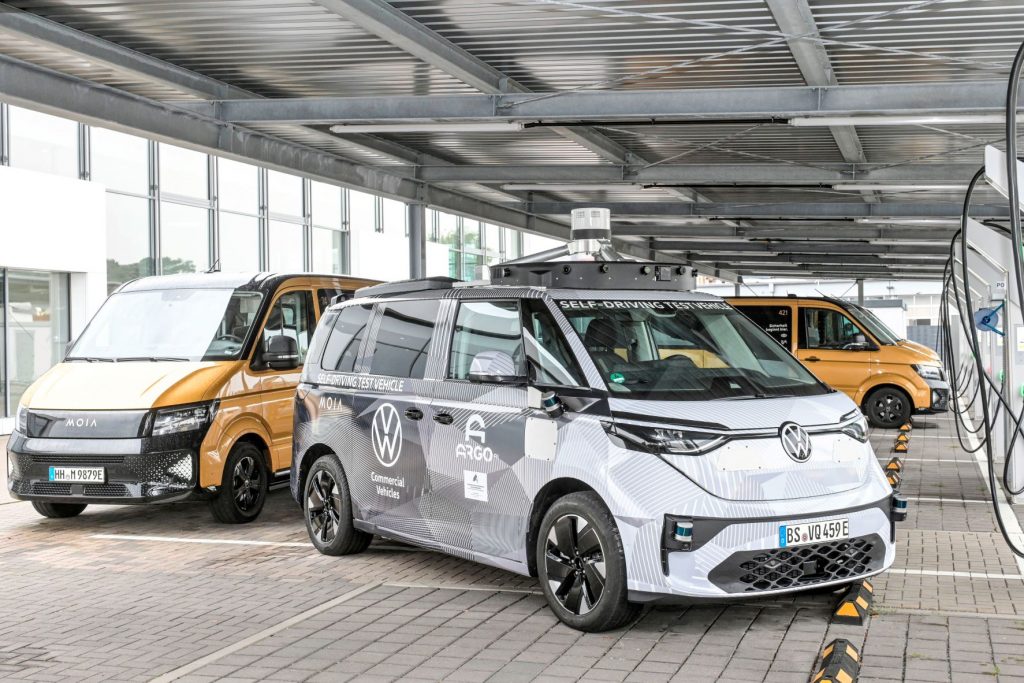
The announcement in 2019 that Tesla planned to build a new “gigafactory” outside Berlin was seen as a threat to the traditional German car industry. Could the old-line automakers keep up with Elon Musk, the industry’s disruptor-in-chief?
Three years later, the answer seems to be jawohl. Tesla’s gigafactory is almost complete but the German majors are all making significant progress toward electric drivetrains and autonomous driving options. Competition on the autonomous driving front seems to be moving particularly quickly, with all the majors working on SAE Level 2 (semi-automated driving features), Level 3 (limited autopilot), and even Level 4 (fully autonomous) vehicles.
Last December, Germany’s Speed magazine announced that Daimler AG, now Mercedes-Benz Group AG, led Tesla in autonomous driving “by a nose,” as the first company to receive approval from the German Federal Motor Transport Authority to roll out a Level 3 autonomous driving system that can be only turned on for 13,000 km (8100 mi) of major highways and only at speeds of 60 km/h (37 mph).
In May, Mercedes-Benz announced the availability of its Drive Pilot on its S-Class and EQS models. Being able to write an email while stuck in traffic isn’t a cheap thrill, however; the feature Mercedes is billing as “the ultimate luxury experience” will set buyers back €5000 for the S-Class ICE and €7430 for the EQS EV.

The Ultimate Self-Driving Machine?
BMW has also shifted up a gear in its autonomous program with its upcoming generation 7 Series.
As one marketing presentation puts it, the self-driving system will enable BMW to “relieve customers of their driving responsibilities and give them time back for other things.” That might sound odd for a car maker that has branded its vehicles for nearly 50 years as “the ultimate driving machine,” but the marketers’ spin is that its new autonomous features will make driving even better by giving drivers the option to leave the dreary side of driving to the autopilot.
The new features in the model scheduled to be released next year will include a parking memory that allows the driver to record a recurring parking maneuver and an autonomous reversing assistant good for up to 200 m (656 ft). To provide Level 3 support, the Series 7 will also include among its over 30 sensors a LiDAR unit mounted inside its grill providing up to 250 m (820 ft) of forward visibility at multiple levels, radar with a range of 300 m (984 ft), 8-megapixel cameras mounted on the windshield and grill, and a rear-mounted camera.
At the same time, researchers have worked to give the robo-drivers the experience they need to take the wheel, by testing their responses against several million scenarios across its entire route network, according to BMW.

Getting on the Microchipbus
The Volkswagen Group hasn’t stayed in neutral either.
In July, it won special approval from the German cartel office to jointly develop autonomous technology with Robert Bosch, the German automotive, electronics, and appliance giant. Volkswagen is focusing its Level 4 program on ride-sharing services.
“The aim here is to be able to offer complete city journeys including the boarding and de-boarding of passengers as a service autonomously,” said Christian Buhlmann, a spokesman for Volkswagen Commercial Vehicles in Hanover.
Right now, most of VW’s self-driving development is taking place in Munich and Hamburg. Former U.S. engineering partner Argo AI had a base in Munich, where traffic conditions are close to those of many European cities. Hamburg is the home of MOIA, VW’s mobility service unit, which has run commercial shuttles for a number of years.
By 2025, VW plans to graduate to app-based autonomous shuttle services in those two cities. Why cities first? That’s where the passengers are.
“Simply a question of demand,” explained Buhlmann. “We are aiming at big city centers to maximize occupancy 24/7.”
Data to the MOIA shuttles will be streamed from three clouds—the system functions; dynamic route-planning that reroutes as passenger data from MOIA; and the company’s own server, which supplies traffic data. Vehicles will also be supplied with driving recommendations from the MOIA control center in the event of roadblocks or other traffic disruptions.
Volkswagen’s system includes “swarm data” too—intelligence from other VW cars to assist lane functionality.
“Formerly, the system depended fully on camera detection of roadmarks,” Bulhmann said. “Whenever those are missing, an average of all drive routes of previously passing vehicles is then used to coordinate on the road.”
In Hamburg, researchers are also experimenting with car-to-X functionality, technology that enables traffic lights to broadcast information directly to passing cars.
Reeling in the red tape
Meanwhile, regulators are grappling with how and when to incorporate driverless vehicles into human-piloted traffic. In July, the European Union approved a regulation to permit the registration and sale of driverless cars in countries that have approved their use. For now, only Germany and France have done so, but other EU countries are expected to follow.
At the moment, the regulations allow for small series of no more than 1500 vehicles of a particular make per year within the common market. The idea is to enable car makers to gain more practical experience, according to Buhlmann, who expects volume restrictions will be lifted by mid-2024.
Whether hands-free Teslas will be out on the Autobahn alongside their German competitors by then is uncertain.
In California, the company is locked in a dispute with software billionaire and U.S. Senate candidate Dan O’Dowd over the safety of its self-driving cars. The company disputes his claim that Tesla Full Self Driving “drives like a suicidal drunken teenager.”
In Germany, too, Tesla’s self-driving initiative has stalled. German regulators have yet to certify the company for Level 3 driving. In July, a Munich court ordered the company to refund a buyer €120,000 for a Model X SUV because its driver-assistance system did not reliably detect obstacles and could pose a “massive hazard” that might lead to rear-end collisions.

